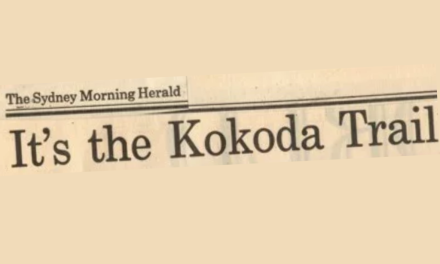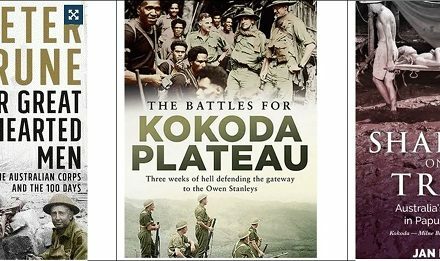by Sally McMillan – The Sunday Telegraph
Sally McMillan from the Sunday Telegraph reports ‘Trekking the Kokoda Trail is all of the above – and more’.
The cloying jungle seeps into you, radiating waves of body heat.
The air is fetid, the dense canopy enveloping – at night ink-black.The track is truly `the devil’s design’.
It shoots up the almighty ridges of the saw-tooth spine of the Owen Stanley Range, plummets down the deepest ravines, crosses the longest spurs. In parts it’s but a foothold wide, flanked only by air and ferns.
You teeter across, not daring to look down, cling to tree roots in cliffs as the pathway vanishes and inch across improvised log bridges with raging white water below.
There are false crests after false crests on a seemingly never-ending journey that’s equivalent in altitude from base camp to the top of Everest.
You battle exhaustion, dehydration, mire, heat, leeches, mosquitoes, lactic acid build-up, blisters, mental angst and self-doubt.
You’re way out of your comfort zone on a track that’s a gut-puncher of an equaliser. It brings out the best – and definitely the worst – in you.
That said, tackling the Kokoda Trail can also be unbelievably exhilarating.
My first foray in 1992 was a far cry from trekking Kokoda today. Few had made the challenge before, there were no commemorative plaques or cairns, no campsites and no other trekkers.
This was a special sortie commemorating the 50th anniversary of the recapture of Kokoda by the Aussies, put together by NSW politician Charlie Lynn – former Army major, Viet vet and ultra-marathoner.
It was a motley group – a handful of journalists, a cluster of seasoned bushwalkers and the amazing Kokoda vet, Les Cook then 70, who as a raw 17-year-old volunteer in the 2/14th Battalion fought across “the hellhole” with gun and bayonet.
Scared but fuelled by adrenalin, we set out from Owers Corner out from Port Moresby and up the skewed, intimidating devil’s ladder that is the 4,000 `step’ Golden Staircase to the razorback spur of Imita Ridge.
It’s a crippling stairway to hell that saw the novices collapse vomiting, seriously questioning our ability to make it past the first day’s agonising 16-hour slog.
Thanks to Charlie – a wicked taskmaster but awesome motivator – our Kioara guides, and Les – who while exhausted and overcome with emotion at times, never wavered – most of us made it in to Kokoda Village nine days later, mightily exhilarated.
My feet were so swollen I couldn’t wear any footwear on the plane home, I had a tropical ulcer and was on a double whammy of antibiotics. No worries. The euphoria overrode all.
I jumped at the chance of joining a second trek with Charlie in 1997, taking a group of Sydney street kids across in a challenge also involving some young Lib movement members and a young corporate team.
We carry everything in on our own shoulders – food, clothes, sleeping bags and tents and divvy up cooking implements along with books, medicines and sports gear for the villagers.
Again, we slog from Owers to Kokoda. Again agonising. Again, most of us made it to our Kokoda Village goal. And again, we were exhilarated.
A third shorter foray in 1998 was an emotional pilgrimage to honour the Battle of Isurava with surviving veterans choppered in for the `Big Parade’ also attended by fellow surviving Fuzzy Wuzzies and hundreds of their children and grandchildren.
Many had walked for days to pay homage to the men who helped save their country.
The veterans and those of us there in commemoration were brought to tears.
People choose to tackle the Kokoda Trail for many reasons – some in remembrance, some fundraising, others as a personal challenge. Many, many don’t make it – for physical and mental reasons.
But for those who do, the track becomes a watershed.
It makes you mine deep your reserves of guts and determination. It makes you confront fears and overcome them. It makes you work as a team.
It makes you comprehend the almighty courage, sacrifice, starvation, agony and mateship of the ill-trained, overwhelmingly outnumbered and outgunned Diggers who battled far, far worse horrors than you can ever confront on the track today.
It makes you aware of the heroics of the Koiara people, their remote village culture and the tribulations of their life that continues today.
If you do make it to the end, you return home with new pride in self and utter respect and awe for those who went before.
Sally Macmillan
Roving Writer
The Sunday Telegraph
2 Holt Street
Surry Hills
2010
(02) 9288 3347




